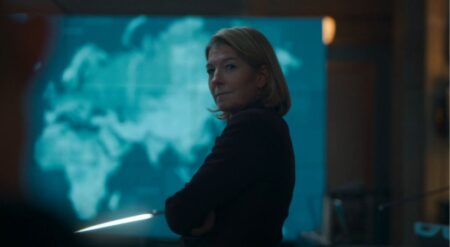The Girls on the Bus Season 1 is a false fantasy. Following a group of female reporters as they follow presidential candidates, the series explores politics, friendship, and journalism through rose-tinted glasses. The series, created by Julie Plec and Amy Chozick, believes it’s radically feminist. And it would be if it had been released in 2005. The world the series operates in would work if it decided to take place in the past. Instead, it’s demonstrating a version of reality that no longer exists.
The series may have worked back when journalism was different and a more employable beast. Back when the political system lived more in a binary and there was a clear right and wrong. When (white) feminism suggested that to be a “good” feminist was to support women first and foremost no matter individual shortcomings and screw the rest. But this isn’t our reality; it’s fiction. The most significant shortcoming of The Girls on the Bus is that it’s buying into its fantasy.
Melissa Benoist plays Sadie, who is getting her second chance. After suffering a public meltdown following a presidential election, she’s stuck to writing light obits for her paper. However, with a new election around the corner, her boss gives her a second chance to follow the candidates. On her adventures, she runs into familiar faces and new ones. These include the influencer Lola (Natasha Behnam), who rose to notoriety due to her activism after surviving a mass shooting. There’s also Kimberlyn (Christina Elmore), who works for a right-wing news outlet, and Grace (Carla Gugino), one of Sadie’s friends and an industry veteran.
We get one of the first glaring issues between these four women. There’s a straightforward, present, reach-across-the-isle intent in the writing. But it’s 2024, and you can’t make me like a conservative character, no matter their backstory or personal plights. Sorry. It’s that energy that speaks to the naivety of the script. Inspired by Chozick’s 2018 memoir Chasing Hillary, The Girls on the Bus Season 1 takes place in a fictional political sphere but hopes to anchor itself in reality. It wholly misses the mark. It’s not just that the characters are unlikable or, often, inept at their jobs. But it’s also because there’s such an obscene self-congratulatory air.

We witness this early in the season when a female presidential candidate, Felicity Walker (Hettienne Park), squares up against a potential voter. The voter in question is throwing out nonsense about “bra-burning feminists” and how it’s people like her who’ve made it so women are no longer in the kitchen where “they belong.” In retaliation and an act of defiance, Walker burns her bra. But this is just one of the many on-the-nose, heavy-handed visual and written moments. In a confrontation between Sadie and Walker, the camera zooms in on a steak knife and a recorder beside each other.
It’s that visual that speaks to what the series thinks of itself. Scathing, hard-hitting, and lethal in its depiction of American politics. And there is a level of authenticity to bits and portions of the series. There’s no denying Chozick’s clear understanding of the mechanics of political journalism. But this isn’t The West Wing. It’s The Newsroom. It’s the moment in Daredevil (stay with me) when Karen is allowed to be a reporter because she has one good idea but no actual skill.
The actors deliver serviceable, if uninspired, performances. Gugino fares best, mainly due to her inherent poise. She helps enliven the screen presence of her partners, too. Benoist is far from a natural screen presence but has sparks of charisma. Behnam is engaging despite frustrating moments, and Elmore does her best with her shaky character. Brandon Scott as a past hook-up of Sadie’s delivers a scene-stealing performance. There are credible elements, but they never amount to anything worthwhile.
No matter how much charisma the actors bring, it can’t make up for the clumsily written characters. Characters who are at the top of their game despite the personal hurdles when we meet them. However, they often shoulder the burden of convenient writing. Sadie is supposed to be a hotshot reporter on the rise but needs to be told to be objective in a significant article. Lola is a confident content creator who wants to redefine media but doesn’t know what a press embargo is. No one seems capable of turning their phone volume down. Its soap opera logistics are being treated with high-brow handling.
There’s nothing wrong with good, entertaining dramas that err on the side of larger-than-life narratives. What’s troublesome is that The Girls on the Bus fails to recognize itself as such. From poorly choreographed fantasy sequences to rote narration driving us through the series, the venture plays fast and loose with big moments. There needed to be greater levity despite the dramatic story it’s telling. It required a marriage of the superfluous with the grounded to anchor the story in something relatable. Instead, we get a story of journalism that’s out of time and out of touch.
The Girls on the Bus Season 1 is serviceable at best. It suffers because there’s such a clear need to prove itself in the writing that it doesn’t deliver. There’s promise, somewhere, buried in the Gen Z fearing buzzwords, bizarre politics, and all of the silly, ridiculous hats they make Benoist wear. But the series never lives up to the self-built hype it fuels itself with.
The Girls on the Bus Season 1 premieres March 14 on Max.
The Girls On The Bus Season 1
-
Rating - 5.5/105.5/10
TL;DR
The Girls on the Bus Season 1 is serviceable at best. It suffers because there’s such a clear need to prove itself in the writing that it isn’t delivered.








